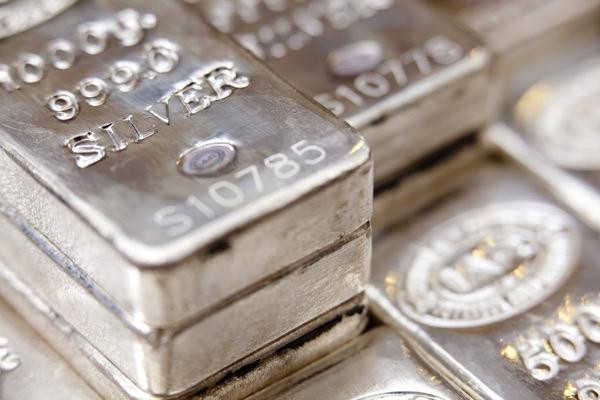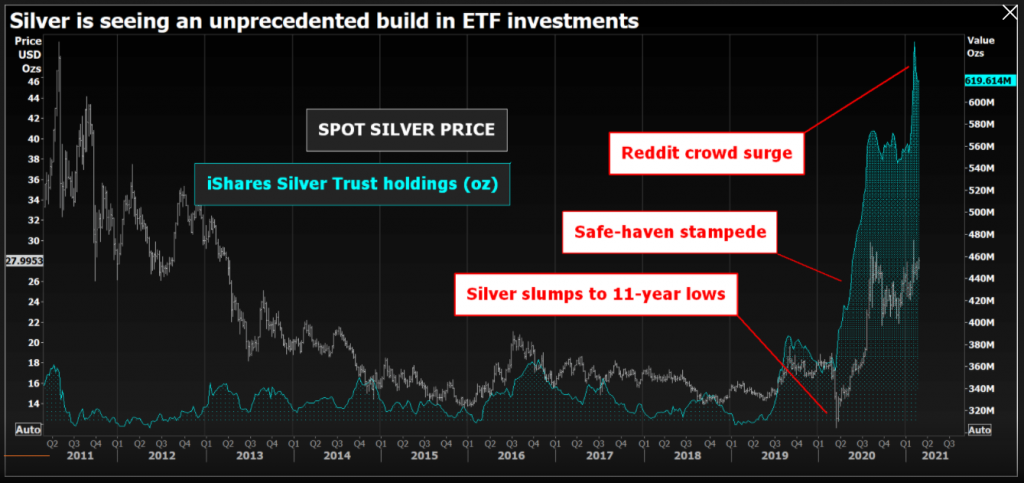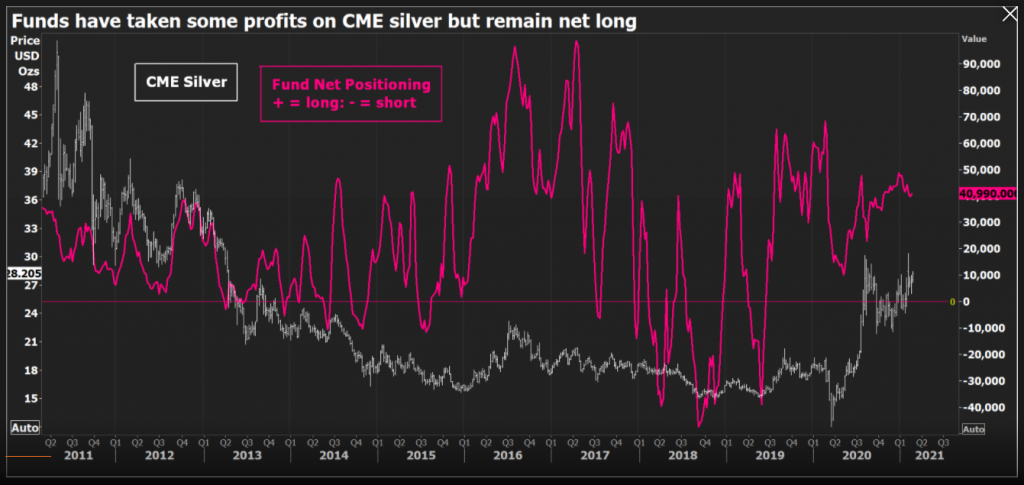
(The opinions expressed here are those of the author, Andy Home, a columnist for Reuters.)
This month’s crowd surge on the silver market quickly dissipated after the price lost momentum above the $30-per ounce level and fell back just as sharply as it had risen.
The Robinhood army has been in retreat ever since.
The iShares Silver Trust (SLV), a physically-backed exchange traded fund (ETF), was the prime conduit for the mass attack. It has seen redemptions equivalent to 65 million ounces, a near 10% drop in holdings, since the start of February, when the hunt for the mythical big silver short was in full cry.
Investor appetite for silver ETFs has been breaking historical records since March last year
The outflows, however, have now stopped and holdings are a lot higher than they were before the Reddit message-boards lit up the market.
Some of the recent arrivals, it seems, are going to stick around for some more silver action. They join a growing army of retail silver bulls, most of whom got into the market last year.
Wall Street’s finest like it at as well, Goldman Sachs describing silver as its “preferred precious metals” due to its combination of dollar-debasement and green industrial themes. (“Silver remains the populist’s metal”, Feb. 2, 2021)
Both sides of silver’s split investment-industrial personality are currently shining, uniting investment bankers and retail punters in a common bull cause.
But this being what veteran traders call the devil’s metal, such a happy state of harmony is unlikely to last.

Investor appetite for silver ETFs has been breaking historical records since March last year.
Total holdings rose by 45% in 2020 to exceed 1 billion ounces for the first time ever and they have risen another 100 million so far this year even allowing for this month’s sell-off, according to analysts at Metals Focus. (“Precious Metals Weekly”, Feb. 23, 2021)
SLV, the largest silver ETF, held 364 million ounces of silver at the start of 2019. It now holds 620 million. Prior to last year the all-time record was 388 million in September 2019.
Investor interest surged in response to the first wave of the covid-19 pandemic. Social breakdown and the likely massive fiscal response triggered a stampede into save-haven hard assets such as gold and silver.
Institutional money largely flowed into gold, which also saw a sharp rise in physical ETF holdings, while retail traders flocked to silver.
Whetting bull appetites further was the fact the silver price had just hit an 11-year low of $11.62 in March due to a collapse in industrial usage.
It’s noticeable that funds trading on the CME’s silver contract reversed positioning from net short to net long at exactly the same time as money was flowing into SLV and other ETFs.
Money managers have stayed collectively bullish since to the tune of 40,990 contracts in the most recent Commitments of Traders Report.
The net long positioning has fallen slightly since the early-February price spike, suggesting light profit-taking, but money managers, like retail ETF investors, are staying in the game in expectation of further price rises.
ETF investments are particularly “sticky” because retail traders are often quick to buy into dips but slow to take profits, according to Metals Focus.
So it is proving with the most recent Robinhood newcomers to the market. Current SLV holdings of 620 million ounces are still up significantly on the 567 million held on Jan. 28, just before the Reddit-triggered buying storm broke.
Metals Focus expects investment inflows to continue as the market refocuses on silver’s industrial properties.

The silver price was crushed by the metal’s industrial exposure last year as lockdowns caused sharp drops in manufacturing activity.
But it’s silver’s industrial profile that is now catching the attention of heavy-weight banks such as Goldman Sachs, which notes “silver has been outperforming gold in line with the recovery in global industrial output”.
The Silver Institute is forecasting industrial demand to rise by 9% this year to a four-year high 510 million ounces, led by the electrical and electronics sector.
In this respect silver is following the upwards arc of industrial metals such as copper, which is on a turbo-charged rally back to 2011 levels.
Moreover, silver’s usage via electronics in 5G technology, expected to rise by 7% this year, and in solar panels puts it on the green recovery radar.
Until very recently solar wasn’t considered that exciting a short-term prospect for silver because build-out of capacity was slowing and panel manufacturers have been using ever smaller amounts of what is a relatively high-cost input.
“Silver usage per (photovoltaic) cell has fallen by an estimated 80% over the past decade and is projected to decline by up to a further 55%,” according to Macquarie Bank. (“Silver’s solar scenarios”, Feb. 17, 2021)
But upending what was a fairly placid outlook has been the combination of China committing and the United States recommitting to carbon neutrality by 2060 and 2050 respectively.
US politics might diminish President Biden’s grandiose green infrastructure plans but “there is clear potential for upside risk on renewable investments on a five-year view,” according to Macquarie.
China is expected to move faster with all eyes on the pending details of the new five-year plan, which is expected to be heavy on green technology.
An acceleration in solar power roll-out could swing the silver usage pendulum even if, as expected, thrifting continues.
Silver’s investment and industrial narratives haven’t fully coalesced yet. It’s unlikely that any investors buying into a silver ETF last summer were doing so in expectation of a global policy shift towards decarbonisation.
But silver’s dual personalities are bullishly aligned for now.
“The outlook for the silver price in 2021 remains exceptionally encouraging, with the annual average price projected to rise by 46% to a seven-year high of $30.00 per ounce,” according to the Silver Institute.
That’s an average price forecast. This being silver, currently trading just shy of that target at $28 per ounce, it could be a bumpy ride.
The sheer size of the ETF physical holdings is itself now a source of potential price instability.
No-one expected investment to mushroom in the way it did last year. With silver now brightly illuminated on the investor radar after the Reddit-driven surge, it seems yet more is likely to be drawn to the market.
However, the more those ETF holdings grow, the more acute the question of what happens if there’s a collective rush for the exit door.
Silver’s current harmonious alignment of investment and industrial drivers may not last long.
Comments